#deutsches oper berlin
Text
Review: "Die Zauberflöte" at the Deutsches Oper, 2 Mar 2024
The opera started at 19:30 and ended around 23:00.
This version is certainly a cut of the original, but not in a bad way. I have not had the chance to see another version of this work, nor to do an in-depth analysis of the work in an academic sphere.
The performances from the individual actors were high quality. I'm not overly confident about the names of the actors, but I believe that the main cast was (in no particular order) Ante Jerkunica, Kieran Carrel, Diana Schnürpel, Lilit Davtyan, Sua Jo, Artur Garbas, and Burkhard Ulrich. Ms. Schnürpel did well with the TikTok infamous Aria, "Der Hölle Rache kocht in meinem Herzen."
I found many of the practical stage effects to be pleasing, especially the snake and the fire of Act 2, Scene 7.
I enjoyed the plainness of the costuming system: people wearing white and yellow were good, the people in black and grey were bad. However, there were some elements of certain costumes that would not be so acceptable in the U.S., due to their similarity to certain racial stereotypes and racial "costumes."
As far as the core material, I found the music pleasant, much of the comedy to be genuinely comedic, but the rest of the writing to be... far from the strongest element. The Wikipedia page mentions that it was inspired by Mozart's interest in Freemasonry; this is a massive understatement. Subtlety is not a strong suit in this one. Additionally, it is very heavy-handed with the "women are evil" themes, the cult vibes are blatant at best, the pro-slavery stand is a bit much, and, in general, I do not consider it to be an impressive piece in terms of story writing.
Somehow, despite all of this, I actually do recommend that people take advantage of the chance to see it, if able.
1 note
·
View note
Text
Zdenko & Matteo 🌈🏳️⚧️💞













Deutsche Oper Berlin 2023
From BFFs to BFs
#opera#opera tag#Arabella#Arabella opera#Operablr Pride Month 2024#trans opera#Richard Strauss#Hugo von Hofmannsthal#Elena Tsallagova#Robert Watson#opera performers#sopranos#tenors#opera gifs#Deutsche Oper Berlin#they were in love from the beginning#it just took Matteo a minute#that one where they're almost kissing he's getting into it before realizing#but also like. he's okay with it
6 notes
·
View notes
Text

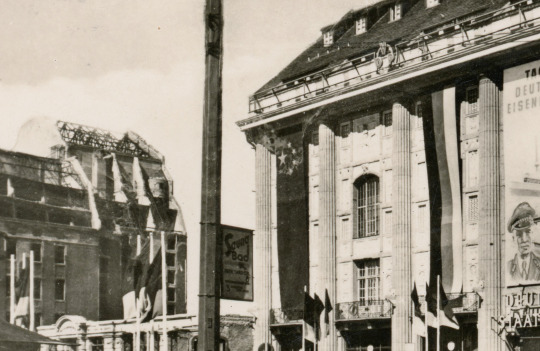
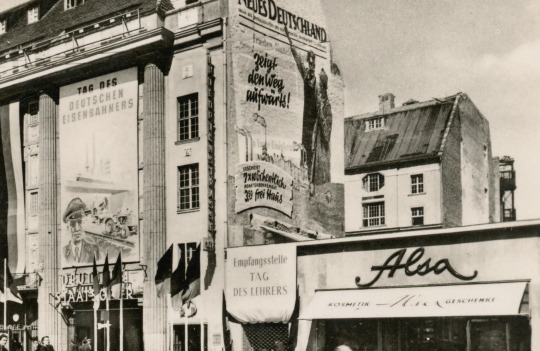




Ansichtskarte
BERLIN
Deutsche Staatsoper
mit Presse-Café
gelaufen 1955
#Berlin#Oper#Deutsche Staatsoper#1950er#Presse Cafe#Pressecafe#Philokartie#DDRPhilokartie#Architekturphilokartie#Friedrichstraße#Admiralspalast#TagDesLehrers#TagDesDeutschenEisenbahners#Alsa#AlltagskulturDerDDR#Ansichtskartenfotografie#AnsichtskartenfotografieDerDDR#NeuesDeutschland#deltiology#VintagePostcard
5 notes
·
View notes
Text
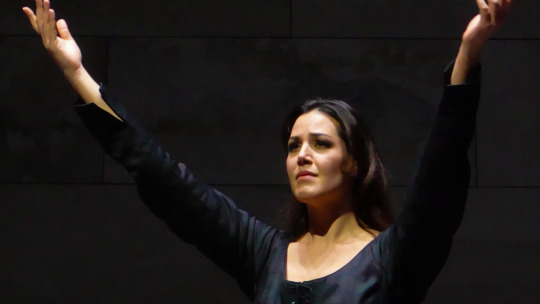
16 March 2024, Berlin
Federica Lombardi (my niece) as Anna Bolena at the
Deutsche Oper Berlin
Photo nerosunero
0 notes
Text


Antikrist (1930) - Rued Langgaard
"Progress" is the byword. "Growth" is the ground of life. "Adversity" strengthens the will. "Struggle" prepares the victory. "Plans" further the work. "Objectives" awaken deeds. Clarity here and clarity there. Firm resolutions – slave of society.
#antikrist#rued langgaard#opera#oper#deutsche oper berlin#seen in berlin#seen in january 2024#mit u.
0 notes
Text
Behold my magnum opus
(list of Rodrigos under the cut)
In order of appearance:
Dietrich Fischer-Dieskau (Deutsche Oper Berlin, 1965)
Étienne Dupuis (Metropolitan Opera, 2022)
Mariusz Kwiecień (San Francisco Opera, 2016)
Sherrill Milnes (Metropolitan Opera, 1980)
Simon Keenlyside (Royal Opera House, 2008)
57 notes
·
View notes
Text


transcript of Five's case files on the Hindenburg, the case that he solves for the Commission while working in management:
MEMORANDUM ON INTENDED EVENTS
RE: HINDENBURG DISASTER
May 6, 1937
The airship will complete its first scheduled demonstration flight for the 1937 season, between Frankfurt, Germany, and Lakehurst. It will depart from Frankfurt about 8:15 P.M, G.M.T., Monday, May 3, and will be due at Lakehurst on the morning of Thursday, May 6. It will be due out of Lakehurst at 10:00 P.M E.S.T, that night. Because of unfavorable winds encountered en route, its arrival at Lakehurst will be deferred until 6:00 P.M, Thursday evening, and departure will be postponed until midnight or later in order to reservice and prepare for the voyage.
The ship is owned and operated by the Deutsche Zeppelin Reederei, G.m.b. H, of Berlin, W8, under den Linden, Germany. The flight, which is intended to be one of a series to be arranged into the United States territory during 1937, will be authorized by a provisional air navigation permit from the Secretary of the Navy to the American Zeppelin Transport, Inc., of 354 Fourth Avenue, New York City, as general United States agent of the Deutities at the Naval Air Station at Lakehurst.
On March, 1937 the German Government will renew the airworthiness certification of the aircraft, reporting that all of its safety devices had been inspected and found satisfactory.
Personnel, including officers, numbered 61, will be on board, of whom 22 will die as a result of the accident.
Passengers, 36 persons besides the Crew will be on board. Of these, 13 will die as a result of the accident. Other passengers and members of the crew will sustain serious injuries.
Total weight of the freight carried will be 325 pounds and will be stowed in the main freight compartment at Frame 125; 2 dogs will be kenneled at Frame 92, and 3 packages will be stowed in the control car. Mail will be carried in a compartment on the top of the control car. Of the freight and mail on a few pieces of mail will be recovered.
The ground personnel will consist of 92 naval personnel and 139 civillians. Practically all of the gorund crew will have previous experienve landing airships. One member of the ground crew will die as a result of burns received during the accident.
Across the Atlantic from Germany to the United States, the flight will be uneventful, save for retarding winds which will not be unusually turbulent. The route traveresed by the ship on this side of the ocean will be from Nova Scotia, vis Boston, Providence, Long Island Sound, New Forks and thense cruise along the coast for a few hours before retracing its course from Tuckerton N.J., to the naval Air Station.

ATMOSPHERIC ANOMALIES PRESENT
The 7:30 A.M, EST. U.S. Weather Bureau map of the vicinity, including the northeastern tier of states, Shows a disturbance over central New York and northeastern Pennsylvania, with a cold front extending from this center Southwestward to West Virginia. This front separated neutralized polar air to the east of the cold front which had become warmer and more moist and neutralized colder air to the west of the front. The warmer and more moist mass of air covered the Middle Atlantic states, southeastern New York and southern New England.
---
The cold front advanced eastward during the day from central Peensylvania at a rate of 12 to 15 m.p.h., passing Lakehurst shortly after 3:30 P.M There was not quite sufficient surface heating during the early afternoon to set off a thunderstom at Lakehurst, and it was not until the front passed and some slight lifting of the air mass occured that a thunderstorm began, The records of the Naval Air Station show that the thunderstorm began at 3:43 P.M and ended at 4:45 P.M
---
Telegraphic reports indicate, the thunderstorms in and to the west of New Jersey were not severe; nor were they of a well defined squall character. Between 12 P.M and 1:30 P.M E.S.T., these storms extended in a definite belt over the region of Harrisburg, Pa., northeastward to Bear Mountain, N.Y., and New Hackensack, N.Y. Between 1:30 and 2:40 P.M, none was reported. Between 2:40 and 3:40 P.M, Camden and Fort Monmouth, N.J., only reported thunderstorms. Between 3:30 and 4:30 P.M, Lakehurst, Mtchel Field, N.Y, and Floyd Bennett Field, N.Y., reported them. Between 4:40 and 5:40 P.M. none was reported; and betweeen 5:40 and 6:40 P.M, Floyd Bennett onlt reported one. Summarized, the thunderstorms in eastern New Jersey were of a local character and not severe.
---
The New York Weather Bureau office bulletin issued at 1:20 P.M, May 6th, follows:
"1800 G.C.T. Moderate wind shift with increasing and lowering clouds possible thundershowers New York and vicinity expected in middle or late afternoon Stop New York Scattered cumulus and small cumulo nimbus approaching from west - visibility excellent surface wind south 12 miles - barometer 29.68 falling steadily temperature 66."

DATE: May 6 1937 0725 EST
OPERATION: Hindenburg Disaster DAMAGE: Catastrophic
PLACE: Lakehurst, New Jursey, 40.026088, -74.316592
LOCALE: Open air field
WEATHER: Light rain
PILOT: Commercial
TOTAL HOURS: 567 ALL 63 NO TYPE
LAST 90 DAYS: 179 ALL 62 NO TYPE
CASUALTIES: Crew: 23; Pass: 13
OCCURENCE: Numerous expert and lay witnesses on the field testified as to where they first observed the fire on the ship. There was great diversity in this testimony for reasons that are very apparent.
Among the most important of these reasons were the extreme rapidity with which the fire spread, the different positions of the witnesses with respect to the ship, the size of the ship, more than one-sixth of a mile in length, and an over-all height, equicalent to a twelve story building, and the fact that the interval between the first glimpse of flame and the impact of the main body of the ship with the ground was 32 seconds.
The great majority of the ground witnesses who testified as to the first sppearance of fire were looking at the port side of the ship.
After carefully weighing the oral evidence and transcribing to a master diagram the numerous disgrams on which the gound witnesses indicated their first observations of fire, we conclude that the first open flame, produced by the burning of the ship's hydrogen, appeared on the top of the ship forward of the entering edge of the vertical fin over Cells 4 and 5.
The first open flame that was seen at that place was followed after a very brief interval by a burst of flaming hydrogen between the equator and the top of the ship.
The fire spread in all directionsmoving progessively for ward at high velocity with a succession of mild explosions. As the stern quarter became enveloped, the ship lost boutanct and cracked at about one-quarter of the distance from the rear end.
The forward part assumed a bow-up attitude, the rear appearing to remain level. At the same time the ship was settling to the ground at a moderate rate of descent.
Whereas there was a definite detonation after flame was first observed on the ship, we believe that the phenomenon was initially a rapid burning or combustion - not an explostion.
From the observations made, is appears that there was a quantity of free hydrogen present in the after part of the ship when the fire originated.

HINDENBURG DIASTER
INTELLIGENCE SUMMARY
Place | Date | Hour | Summary of Events and Information | Remarks
FRANKFURT April | 2. | A deviation occured in the subject's plot to detonate a controlled explosive device on the rear fuel tank of the zeppelin. An alternate plan is underway. | EF
5. | Progress in the creation of the subject's explosive device has stalled. An alternate catalyst is still viable. | SB
7. | The zeppelin has successfully completed it's seventh cross-continent trip carrying 19 crew members | -
LAKEHURST May | 9. | Lakehurst Nacal Air Station recevied 8 new directives in preperation for the first cross-continent civilian flight of the zeppelin. German and American organizations continue to increase communications. | EF
12. | Progress continues on the controlled explosive device. Another player emerges in America, a linesman from New York. | SB
15. | The zeppelin is grounded for 2 days as high winds buffer the Western coast of the English Isles.
FRANKFURT June | 29. | 300 feet of steel is salwed and loaded up at Frankfurt for repaits to the central gangway after miscalculations in the rate of expansion cause cells 15 and 16 to bend 4 degrees outside of normal variation. | EF
Instructions regarding Intelligence Summaries are contained in Regula II and the Management Manual.
Title pages will be prepared in manuscript.

The airship will be placed in service early in 1936. It will bear the builder's numer LZ 129 and have been constructed by the Luft Schiffbau Zeppelin of Friedrichschafen, Germany, and organization which also built the 118 Zeppelin type airships. Briefly described, this type of design provides for frame work of duralumin metal girders with tension wires. There is division by fringe wirings of the bosy into different compartments, into which the gas bags are placed to received the lifting gas; a keel walkway to take certain load; a framwork with an outer cover of fabric to give form, and engine cars suspended from the frame outside the ship. The Hindenburg is a Zeppelin type airship, having an axial corridor constructed longitudinally through the center of the hull.
During its 9 months of operation in 1936, this airship will make more than 55 flights; flying 2,754 hours, cruising 191, 584 miles, crossing the ocean 34 times, carrying 2, 798 passengers and more than 377,000 pounds of mail and freight, all without mishap.
The Hindenburgs length is about 803.8 feet; height, 147 feet; maximum diameter, 135 feet; fineness ratio, about 6; total gas volume, 7, 063, 000 cubic feet; normal volume, 6, 710, 000 cubic feet. Weight of the ship with necessary equipment and fuel is 430, 950 pounds; maximum fuel capacity, 143, 650 pounds; total payload 41, 990 pounds, and total life is 472, 940 pounds. Cruising speed is about 75 statute m.p.h.; maximum speed is slightly over 84 m.p.h. Passenger space is entirely within the hull.
The control system is the conventional Zeppelin type control, with two rudders acting as a Unit for horizontal control, and two elevators acting likewise for veritcal control. Emergency elevator and rudder control wheels are installed in the stern of the ship. An electrical gyroscopic device attached to the forward rudder wheel provides automatic steering.
23 notes
·
View notes
Text
GE PowerHaul

After I offered, @valtionrautatiet-official asked me to post some pictures of the locomotive that is nowadays known as the Dr20, used by the private freight operator North Rail in Finland. Here it is in 2012, long before anyone ever even considered sending it to Finland, in Berlin. The reason that it's in Berlin specifically is that it's at Innotrans, the biggest trade fair and exhibition for railroads that exists. At this point it had the paint job of HHPI (Heavy Haul Power International, despite the important sounding name really just one of many European freight rail companies with headquarters in Germany), with their trademark blue and red and their company policy of putting Newton's second law on it. "Project Power" also sounds cool, doesn't it? Well, it turns out they never entered service for HHPI. Way too much history under the cut.
The story behind these eight locomotives is weird and opaque, and there is a lot of stuff we may never know, but on a very fundamental level it seems to be one of the victims of what I call the six-axle diesel curse. This basic of that theory of mine is that it's impossible to sell big, heavy, powerful diesel locomotives, the kind that are so powerful that they need six axles for all the weight from their big engine and diesel tank, in (West) Germany and to a certain extent central and Western Europe, at least nowadays, unless you do it by accident.
The German locomotive industry has wanted to build big six-axle diesel locomotives since the end of steam traction. There was a prototype six-axle version of the V 200, named V 300, in the 1950s, but DB didn't want it (a related but less powerful version was sold to Yugoslavia to haul Tito's private train). For the Americans here, the Krauss-Maffei locomotives of the Southern Pacific and Rio Grande were related to that.
A few years later, in 1962, we get the V 320, a six-axle version of the V 160 locomotive family. The four-axle version was very popular and is still in service, but they only built the prototype of the six-axle version. Interestingly, that one prototype is still around as well, hauling construction trains. Deutsche Bahn was never interested, they preferred the flexibility of having more smaller units. And anyway, they were busy electrifying the busy main lines that would have made the most use of those heavy machines.
In the 1970s Henschel and BBC (the electric equipment one, not the British TV one) built three copies of the DE 2500 both with four and six axles, but those were really more experimental machines.
In the late 1980s and early 1990s, MaK tried to sell their DE 1024, and I actually have a picture of that ne.
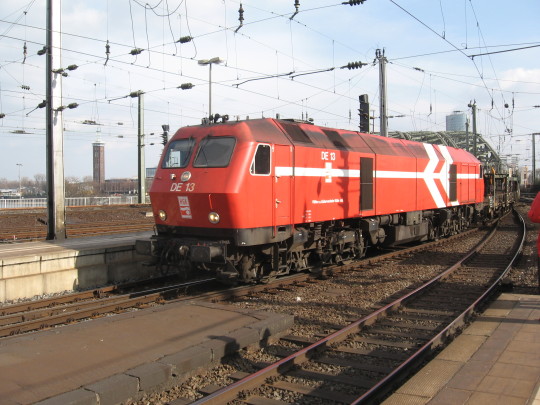
They built three prototypes, and Deutsche Bahn seemed to genuinely toy with the idea… but in the end it was decided to electrify the lines in the (mostly flat) north that hadn't been electrified yet anyway.
And at the same time, the wall fell, and suddenly Germany had access to all the locomotives of the east, now mostly surplus since mostly the industry they served did not survive the transition to western markets. East Germany had bought powerful six-axle diesel locomotives in enormous numbers from the Soviet Union, specifically modern-day Ukraine, and those were available, good enough and already paid for. In particular the class 232 and related, known as "Ludmilla" among rail fans, have proven very useful.
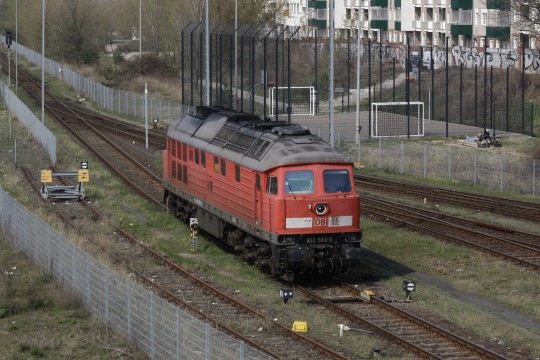
MaK was able to sell an altered version of that locomotive to Norway, but that turned out to be be a huge disaster as they developed a habit of catching on fire. Eventually Siemens (who briefly owned MaK) had to take them back, and since then they've changed hands an astonishing number of times - apparently right now Hector Rail and RDC Autozug have a lot of them. Here's one in Hamburg Altona when it was used on regional trains there.

The three prototypes went to locally owned operator HGK, where two of them also burned down. DB probably dodged a bullet there. Interestingly enough, the only one that didn't burn down was number 13, but that was finally scrapped a few years ago.
In the mid-1990s, ADtranz (later Bombardier) and GE got together to build the Blue Tiger locomotive, a very distinctive-looking and noisy machine. They sold 11 to various private operators in Germany, 30 to Pakistan and 20 to Malaysia. Not terrible, but not a huge success either.
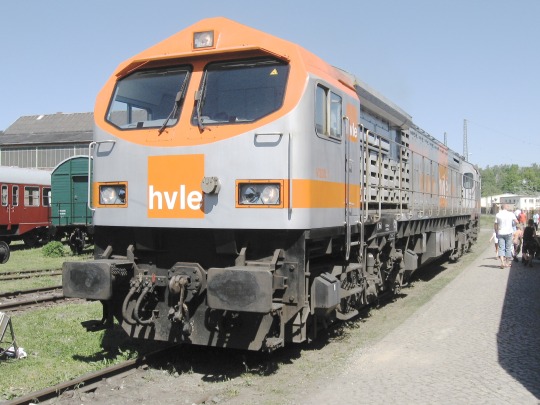
But in the 2000s, things were changing. Liberalisation meant that more and more companies were running services all throughout Europe. The busy main lines were electrified, but many of the border crossings weren't yet, so there was a new need for big six-axle diesel locomotives.
The big beneficiary of this was EMD from North America, who were already supplying such locomotives to Great Britain. The rail companies there needed these machines to replace unreliable British-built power, and to replace environmentally friendly electric locomotives, because most of the British network is not electrified and the few sections that are have way too much traffic on them.
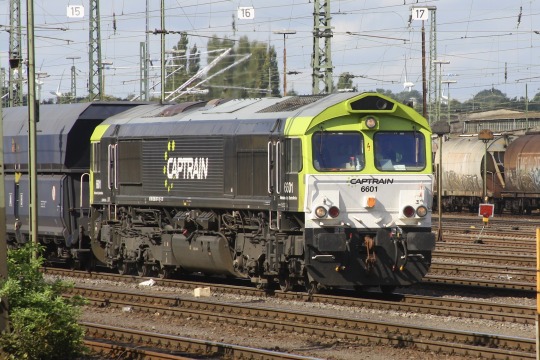
The Class 66 is an ugly mess, designed by figuratively building a metal shed in the inside of a tiny British rail tunnel. It's so noisy that drivers in Norway get hazard pay for being in them. But it works and it was mass produced, and a lot of them made their way to the continent in short order.
Other companies wanted in on that business. Voith decided to enter locomotive building after previously supplying traction equipment. They had high hopes for their Maxima series of locomotives, which they started building in 2008, and they had their own leasing company. They did a lot of marketing and the machine won prestigious design awards.
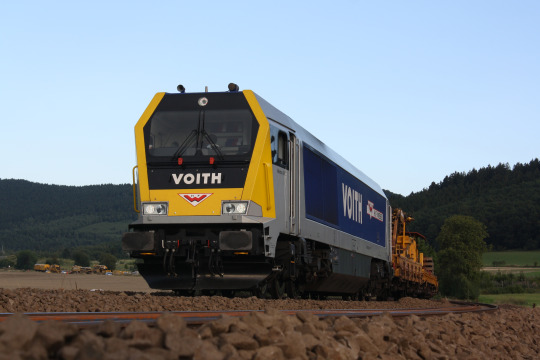
At one point they had a hundred pre-orders. In the end their own leasing company folded, and they only built twenty, which they didn't even manage to sell that quickly. Nowadays they've stopped producing locomotives again.
General Electric, the other North American locomotive company, wanted in on that action as well. Sure, it hadn't worked with the Blue Tiger, but years had passed and things were different now. For their new product, the PowerHaul, they decided to follow what EMD had done. They started with the class 77 for the British market, first shown at Innotrans in 2010.

Then they wanted to work their way out to wider Europe, with a special continental version that was designed with a bigger shell to match the larger tunnels on the continent. That way they weren't quite as cramped. EMD had considered a similar idea, a European-sized class 66, but decided against that.
GE also did not intend to make them themselves. Instead after the initial batch of British 77s, they transferred production to their Turkish partner Tülomsaş, who supplied some more British ones and the ones for central Europe. 29008 is one of them.
In the end all of these plans fell through. A lot of the international border crossings did get electrified much quicker than the diesel sellers had hoped. The one near where I live, the Montzenroute, started electric running in December of 2008, and it was actually the makers of electric locomotives who made bank off of the new international railway world. Here is a Bombardier TRAXX electric locomotive during the first week that freight trains from Germany to Belgium were running with electric power, just a few hundred meters from the border.
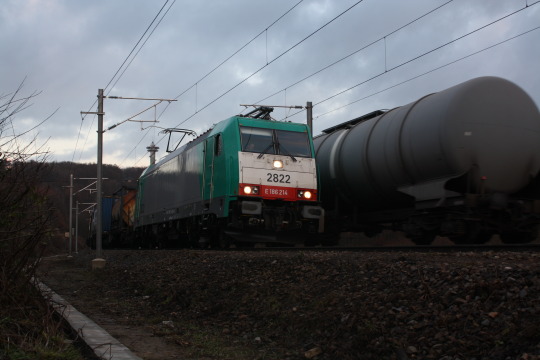
But the business changing is one thing, the story of the PowerHauls seems to be even more complicated. After all, GE did have a launch customer for their PowerHaul, in the form of HHPI. The locomotives were built, painted in HHPI colors, and tested. And then… well, nothing. They never entered service, instead sitting for years in Cottbus, Germany. I have no idea whether they ever got approved for service in Germany. Finnish Wikipedia says "HHPI had no use for them", but that sounds like a euphemism. Clearly HHPI had some use for powerful locomotives, they've recently taken delivery of some Stadler EuroDuals.
The EuroDual and the closely related Euro9000, pictured below, seem to be the solution to the six axle diesel curse though the conceptually simple but technologically difficult trick of simultaneously being a very powerful electric locomotive as well. They have already delivered more of them than Voith Maxima, GE Blue Tiger and GE PowerHaul combined. Sorry for the pictures, they don't park the locomotives well for good photos at Innotrans.
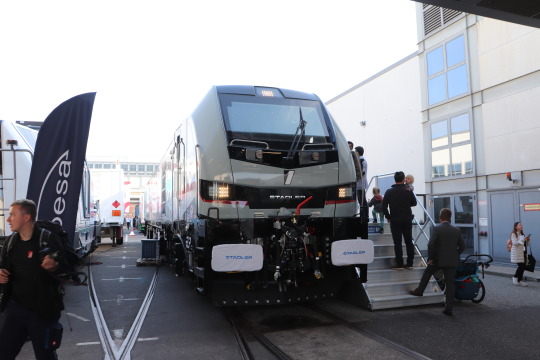
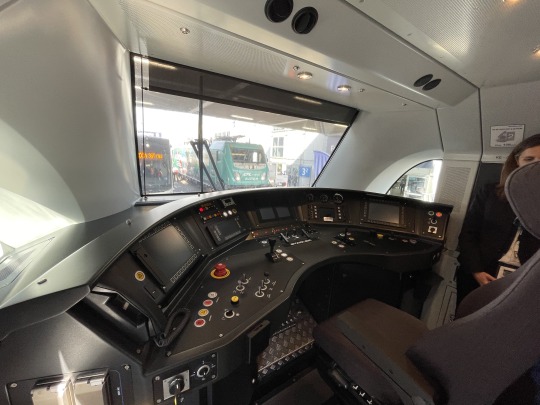
Also, GE was not able to find any customer in Germany, nor in Sweden, where some units of that type were tested at some point. Locomotives of that type were built for Turkey, though, and I haven't heard anything negative about them there. Those were also at Innotrans, in 2014.
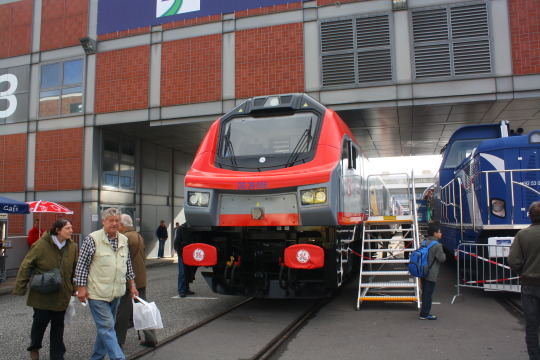
And then, years after everyone had forgotten about these machines, they suddenly turned up in Finland, in the hands of North Rail (formerly Operail), one of the few private companies there. That required at least new couplings, new axles (Finland has a different rail gauge, the measurement of how far the rails are apart), probably adjustments to the breaks, new train control systems and so on.
It's possible that North Rail was thoroughly convinced by the advantages of GE's concept or something, but I think it's far more likely that they just got a really good deal because GE was happy someone took them off their hands.
The reason they're in Finland is almost certainly that Operail needed some cheap machines that weren't doing anything, and these units were just that. But why were they not doing anything? Why were these machines doomed to sit in Cottbus for years, essentially still in new condition, painted for an operator that didn't want them? I'm sure you'll find plenty of theories if you look on online forums, and it's even possible that one of them is the truth, but unless some rail journalist decides to really dig into that, we'll probably never know for certain.
If you allow me to speculate: It certainly doesn't sound like a success story, and there have been all sorts of other stories where trains didn't get approval to run in the country they were ordered for, or had severe technical defects. Ask an Austrian rail fan about the Talent 3, a danish about the IC 4 or a dutch or Belgian about the Fyra to get some really fun rants. I don't know if these locomotives belong in that hall of shame, but it would certainly be an explanation.
My guess is that there won't be any more of these machines ever. GE Transportation doesn't even exist anymore, the whole part of the business got sold to Wabtec a few years ago. But if these machines are doing well in Finland now, good for them! Finally someone found something to do with these weird-looking units.
16 notes
·
View notes
Text
TOM WLASCHIHA IM FRAGEBOGEN:„Keine Rituale, keine schwarzen Katzen“
link https://www.faz.net/aktuell/stil/trends-nischen/tom-wlaschiha-schokolade-dunkle-schokolade-19024851.html
TOM WLASCHIHA IM FRAGEBOGEN:„Keine Rituale, keine schwarzen Katzen“


Tom Wlaschihas Name dürfte vielen „Game of Thrones“-Fans ein Begriff sein.
VON JOHANNA CHRISTNER, BERLIN
31.07.2023-17:24
Tom Wlaschiha ist seit einer Hauptrolle in „Game of Thrones“ weltweit bekannt. Im Stil-Fragebogen verrät er, was er immer im Kühlschrank hat und was ihn an Postkarten nervt.
Nach Nebenrollen in internationalen Filmen wie „Operation Walküre – das Stauffenberg Attentat“ ist das Gesicht von Tom Wlaschiha den meisten inzwischen wohl aus der amerikanischen Fantasy-Serie „Game of Thrones“ bekannt, in der er über mehrere Staffeln hinweg als Jagen H'ghar einen der Hauptcharaktere verkörperte. Der Fünfzigjährige war zudem in Großproduktionen wie „Stranger Things“ und „Tom Clancy's Jack Ryan“ zu sehen. Das Schauspielhandwerk erlernte der gebürtige Sachse, der in einer Kleinstadt nahe Dresden aufwuchs, an der Hochschule für Musik und Theater „Felix Mendelssohn Bartholdy“ in Leipzig – und kann sich bis heute auch für deutsche Produktionen wie den „Tatort“ begeistern. Für die Podcast-Serie „Marvel's Wastelanders: Star-Lord“, erschienen Ende Juni auf Audible.de, darf es auch wieder deutsch sein: Zehn Episoden lang leiht Wlaschiha darin dem Marvel-Helden Peter Quill seine Stimme.
Was essen Sie zum Frühstück?
Einen Kaffee und eine Zigarette. Manchmal noch ein Müsli hinterher.
Wo kaufen Sie Ihre Kleidung ein?
Ich kaufe nur sehr selten Kleidung ein. Und wenn, dann komme ich zufällig an irgendeinem Laden vorbei, gehe mit einer halben Stunde Zeit rein, und mir gefällt etwas. Das ist wirklich völlig ohne System. In den vergangenen Jahren habe ich hauptsächlich historische und Fantasy-Filme gedreht, da war nicht viel Alltagstaugliches dabei, was ich von einem Dreh hätte mitnehmen können. Obwohl das in Kreuzberg, wo ich wohne, wahrscheinlich gar nicht so auffallen würde, wenn ich das anhätte.
Was ist das älteste Kleidungsstück in Ihrem Schrank?
Ich habe T-Shirts aus den Neunzigern, die für mich damals oversized waren und mir heute passen. Die Shirts sind teilweise einfarbig, teilweise mit Prints. Das allerälteste Shirt aus dieser Sammlung ist ein orangefarbenes Ripp-T-Shirt aus dem Fundus der Schauspielschule in Leipzig von 1992 – das ist auch schon an mehreren Stellen geflickt. Ich habe es schon lange nicht mehr angehabt, aber es hat einen sentimentalen Wert für mich.
Wann haben Sie zuletzt handschriftlich einen Brief verfasst?
Früher habe ich wahnsinnig viele Briefe geschrieben, aber den letzten bestimmt vor zehn Jahren. Vor einigen Urlauben habe ich wieder angefangen, Postkarten zu schreiben. Ich finde diese analoge Schneckenpost ganz cool. Häufig habe ich dann aber das Problem, dass ich Briefmarken kaufen will, die aber nicht bekomme und die Postkarten erst von zu Hause aus verschicken muss. Meine letzte Postkarte kam dann mit einer deutschen Briefmarke. Das ist dann nicht ganz so cool.
Welches Buch hat Sie im Leben am meisten beeindruckt?
Da gab es verschiedene Bücher in verschiedenen Lebensphasen. Als Kind und Jugendlicher habe ich sehr viel Karl May gelesen, in späteren Zeiten fand ich Milan Kundera toll. Mein jetziger deutscher Lieblingsschriftsteller ist Christian Kracht. „Die Toten“ und „Eurotrash“ mochte ich zum Beispiel sehr. Kracht schafft es über eine Sprachreduktion, dass jedes seiner Worte notwendig ist. Und obwohl es Prosa ist, ist da diese wunderschöne Poesie in seiner Sprache – das finde ich toll.
Wie informieren Sie sich über das Weltgeschehen?
Ich bin ein News-Junkie. Ich habe mehrere Zeitungen abonniert und lese die, hauptsächlich auf dem Handy.
Was ist Ihr bestes Smalltalk-Thema?
Ich hasse Smalltalk, halte ihn aber notgedrungen oft. Ich kann zum Beispiel gut über die Absurditäten der Berliner Politik reden.
Bei welchem Film haben Sie zuletzt geweint?
Bei meinen, wenn sie nicht gut waren.
Sind Sie abergläubisch?
Nein, überhaupt nicht. Keine Rituale, keine schwarzen Katzen, die von links nach rechts laufen. Ich laufe auch gerne mal absichtlich unter einer Leiter durch.
Worüber können Sie lachen?
Über ganz viel, über mich zum Beispiel. Ich glaube, ich bin manchmal viel zu albern für mein Alter.
Ihr Lieblingsvorname?
Aktuell wohl Peter und Rocket – die Protagonisten der Podcast-Serie „Marvel's Wastelanders: Star-Lord“, in der ich Peter Quill die Stimme leihe.

Bekannt als Auftragsmörder Jaqen H'ghar aus „Game Of Trones“: Tom Wlaschiha 2015 bei der Eröffnung einer Ausstellung zur Serie
Machen Sie eine Mittagspause?
Ich mache keine Mittagspause, aber was ich echt gerne mag, ist so eine kleine Siesta tagsüber. Es gibt nichts Besseres, als tagsüber zu schlafen.
In welchem Land würden Sie gerne leben?
Ich bin ganz glücklich in Deutschland, habe aber ansonsten eine große Affinität zu Italien. Weil ich das italienische Lebensgefühl sehr mag, die Leichtigkeit, die Italianità. Das Gefühl für Schönheit und Leichtigkeit in Kombination mit der Geschichte. Ich fühle mich in Italien immer sehr wohl.
Was fehlt nie in Ihrem Kühlschrank?
Schokolade! Dunkle Schokolade.
Fühlen Sie sich mit oder ohne Auto freier?
Mit. Ich fahre sehr gerne Auto. Und ich habe ein durchaus erotisches Verhältnis zu meinem Auto.
Was ist Ihr größtes Talent?
Ich bin sehr flexibel und kann mich gut auf Menschen und Situationen einlassen.
Was tun Sie, obwohl es unvernünftig ist?
Kaffee und Zigarette vor dem Müsli.
Welcher historischen Person würden Sie gerne begegnen?
Karl Marx. Weil ich denke, dass er einer der missverstandensten Philosophen ist. Und ich auch denke, dass die Theorie, die er ursprünglich entwickelt hat, mit der Praxis, die ihm zugeschrieben wird, nichts zu tun hat.
Tragen Sie Schmuck? Und eine Uhr ?
Schmuck nur selten. Ich habe ein paar Armbänder, aber ich mag es eigentlich nicht, viel an den Armen zu tragen. Meine Uhr trage ich oft, nur nicht im Fitnessstudio.
Haben Sie einen Lieblingsduft?
Ja, Oud Minérale von Tom Ford, aber das Parfum wird nicht mehr verkauft. Ich habe mir im vergangenen Jahr über dubiose Online-Kanäle noch etwas davon gesichert. Was ich mache, wenn mein Vorrat leer ist, weiß ich noch nicht.
Was war Ihr schönstes Ferienerlebnis?
Da gab es viele. Eines meiner schönsten Ferienerlebnisse war zu Schauspielschul-Zeiten, da sind wir mit Freunden nach Sardinien getrampt. Drei Wochen waren wir dort– und haben nichts gesehen außer dem Strand.
Auf welchem Konzert waren Sie zuletzt?
Das war im Dezember, ein Klassik-Konzert in Barcelona. Bei Ivo Pogorelich, einem tollen kroatischen Pianisten.
Was fehlt Ihnen zum Glück?
Glück ist ein großes Wort. Aber ich bin ziemlich zufrieden, mir fehlt es an nichts.
Was trinken Sie zum Abendessen?
Oft Wein. Im Sommer weißen und im Winter roten. Ein Weinkenner bin ich nicht, aber ich mag zum Beispiel südafrikanischen Rotwein.
22 notes
·
View notes
Text
German rail operator Deutsche Bahn said on Thursday it would improve train punctuality and reliability in the coming six months, after just 62.7% of long-distance trains reached their destination without major delay in the first half of 2024.
Train delays were a major bugbear among football fans visiting Germany as it hosted the Euro 2024 football tournament, prompting widespread commentary on the apparent myth of Germany as a modern and efficent country.
"We are anticipating an improvement in punctuality in the second half of the year," Deutsche Bahn chief executive Richard Lutz said during Thursday's presentation of the company's half-year report in Berlin.
By the end of the year, the aim is for 63% to 67% of long-distance trains to run without major delays.
Just 52.9% of trains arrived on time in the first half of the year, with June being a particularly bad month, Deutsche Bahn said. Trains are considered delayed if they reach their destination at least 6 minutes later than scheduled.
Rail travel across Germany has been hampered by industrial strikes, poor infrastructure and an unexpected number of extreme weather events, according to the state-owned company.
"Taken together, these alone have cost us around 7 percentage points in punctuality," Lutz said.
Rail problems also led to a notable decline in passenger numbers in the first half of the year. The company said that 64.2 million passengers took long-distance trains in this period, 6% less than the same period last year.
To improve train punctuality in the short term, Deutsche Bahn said it plans to have more vehicles on standby to respond to disruptions and outages.
High-speed ICE 4 trains, which make up a large part of the long-distance fleet, are to be prioritized in future for short-term maintenance work so they can quickly return to service.
3 notes
·
View notes
Text
Is this the year I finally go to Berlin?
There's the music and opera reasons to, of course, the Deutsche Oper Berlin and the Komische Oper and the Berlin Philharmoniker, but it's also the city where my grandmother was born and then had to flee in 1933 when Hitler came to power. She got lucky, our family had money and connections in New York. She was three at the time. She's never returned to Berlin, but she still knows the name of the street where my great-grandfather's shop was, not like that really has meaning in postwar Berlin. But I'd try to find it anyway.
She's 93, and I'd like to get there before she dies so I can show her pictures. I know time is running out. I think it has to be this year.
#unrelenting narcissism#my great-grandfather's move to New York is the reason she's alive and wasn't murdered in a concentration camp as a teenager#I think about that a lot#anyway
9 notes
·
View notes
Text
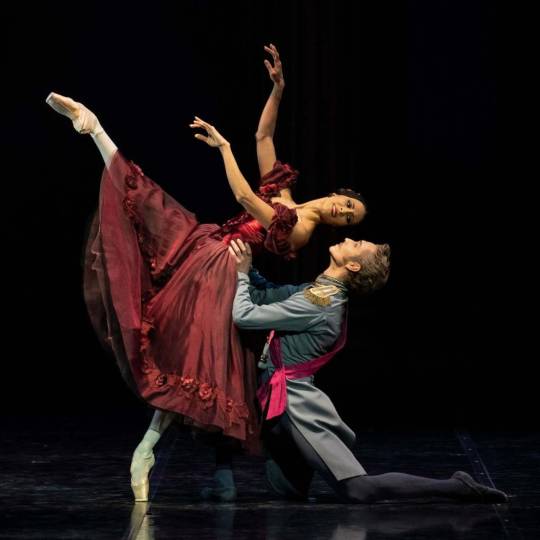
Elisa Carrillo Cabrera as Tatyana Larina and Alexej Orlenco as Prince Gremin, ballet "Onegin", choreography by John Cranko, based on the novel in verse "Eugene Onegin" by Aleksandr Pushkin, music by Pyotr Tchaikovsky, stage and costume by Elisabeth Dalton, Staatsballett Berlin Berlin State Ballet, Deutsche Oper Berlin, Berlin, Germany
Photographer Carlos Quezada
11 notes
·
View notes
Text





In awe at this Barbiere di Siviglia production from Deutsche Oper Berlin for limit-testing the 16th century vibes achievable without actual doublets.
#there are also actual doublets#not that this opera has any relation to the 16th century#but I'll take it#costume tag#charles v tag#rossini
5 notes
·
View notes
Text

Mark Steven Doss (July 2, 1957) is a Grammy Award-winning bass-baritone, specializing in opera, concert, and recital. He has performed major roles with many international opera companies, including Milan’s La Scala, Vienna State Opera, Lyric Opera of Chicago, San Francisco Opera, the Royal Opera House Covent Garden, Deutsche Staatsoper Berlin, Brussels’ La Monnaie, Canadian Opera Company, and Oper Frankfurt.
He was born in Cleveland and attended East Technical High School, participated in varsity sports, took drama and chorus, and performed in a school production of Godspell. He enrolled in the Seminary at Saint Joseph’s College. He continued to take music courses and performed in recitals and musical theatre productions. He left the seminary and became a student at the college, graduating with a BA in music and sociology. He entered the master’s program at Indiana University’s School of Music. His first operatic performance was in the role of Khan Konchak in the Indiana University Musical Theatre’s production of Borodin’s Prince Igor. He performed a total of six roles at Indiana University.
He made his debut at Milan’s La Scala in the role of Escamillo in Carmen. He has been a regular performer at La Scala, most recently in the role of Amonasro in the opera’s production Aida. He performed the roles of Mephistopheles in Gounod’s Faust with Opera Tampa, Amonasro in Verdi’s Aida at La Scala and in Tel Aviv, Jochanaan in Strauss’ Salome with the Deutsche Staatsoper Berlin, and Premysl in Janáček’s Šárka with La Fenice in Venice.
He is married to Dawn Rivard and he has two sons.
He is the recipient of Planet Africa’s 2011 Entertainment Award. He received a Grammy Award for his performance on the Deutsche Grammophon recording of Handel’s Semele. He won First Prize in the International Verdi Competition, as well as being a Metropolitan Opera Finalist Winner. He received The National Institute for Music Theatre’s George London Opera Prize.
He held the position of Associate Professor of Voice at Michigan State University. He continues to give occasional vocal master classes and to work with apprentice artists. #africanhistory365 #africanexcellence
1 note
·
View note
Text
youtube
RIP Robert Hale (1933-2023)
He was one of the great bass-baritones of his time with a long career, mostly in Europe.
I had the pleasure of hearing him live once, on one of the greatest nights of opera I've ever experienced. It was Faust at the Deutsche Oper Berlin, where he played Mephistopheles with the Faust of Giacomo Aragall and the Marguerite of Sona Ghazarian, in the ridiculous and wonderful production of the work by John Dew.
All other Fausts I've seen or heard have not come close to that one magical night in Berlin.
Leb' wohl.
5 notes
·
View notes
Text
Events 6.18 (after 1940)
1940 – Appeal of 18 June by Charles de Gaulle.
1940 – The "Finest Hour" speech is delivered by Winston Churchill.
1945 – William Joyce ("Lord Haw-Haw") is charged with treason for his pro-German propaganda broadcasting during World War II.
1946 – Dr. Ram Manohar Lohia, a Socialist, calls for a Direct Action Day against the Portuguese in Goa.
1948 – Columbia Records introduces the long-playing record album in a public demonstration at the Waldorf-Astoria Hotel in New York City.
1948 – Britain, France and the United States announce that on June 21, the Deutsche Mark will be introduced in western Germany and West Berlin. Over the next six days, Communists increasingly restrict access to Berlin.
1953 – The Egyptian revolution of 1952 ends with the overthrow of the Muhammad Ali dynasty and the declaration of the Republic of Egypt.
1953 – A United States Air Force C-124 crashes and burns near Tachikawa, Japan, killing 129.
1954 – Carlos Castillo Armas leads an invasion force across the Guatemalan border, setting in motion the 1954 Guatemalan coup d'état.
1958 – Benjamin Britten's one-act opera Noye's Fludde premiered at the Aldeburgh Festival.
1965 – Vietnam War: The United States Air Force uses B-52 bombers to attack guerrilla fighters in South Vietnam.
1972 – Staines air disaster: One hundred eighteen people are killed when a BEA H.S. Trident crashes minutes after takeoff from London's Heathrow Airport.[8]
1979 – SALT II is signed by the United States and the Soviet Union.
1981 – The Lockheed F-117 Nighthawk, the first operational aircraft initially designed around stealth technology, makes its first flight.
1982 – Italian banker Roberto Calvi's body is discovered hanging beneath Blackfriars Bridge in London, England.
1983 – Space Shuttle program: STS-7, Astronaut Sally Ride becomes the first American woman in space.
1983 – Mona Mahmudnizhad, together with nine other women of the Baháʼí Faith, is sentenced to death and hanged in Shiraz, Iran over her religious beliefs.
1984 – A major clash between about 5,000 police and a similar number of miners takes place at Orgreave, South Yorkshire, during the 1984–85 UK miners' strike.
1994 – The Troubles: Members of the Ulster Volunteer Force (UVF) attack a crowded pub with assault rifles in Loughinisland, Northern Ireland. Six Catholic civilians are killed and five wounded. It was crowded with people watching the 1994 FIFA World Cup.
1998 – Propair Flight 420 crashes near Montréal–Mirabel International Airport in Quebec, Canada, killing 11.
2006 – The first Kazakh space satellite, KazSat-1 is launched.
2007 – The Charleston Sofa Super Store fire happened in Charleston, South Carolina, killing nine firefighters.
2009 – The Lunar Reconnaissance Orbiter (LRO), a NASA robotic spacecraft is launched.
2018 – An earthquake of magnitude 6.1 strikes northern Osaka.
2023 – Titan, a submersible operated by OceanGate Expeditions, imploded while attempting to view the wreck of the Titanic, killing all five people on board including the co-founder and CEO of the company, Stockton Rush in the North Atlantic Ocean.
1 note
·
View note